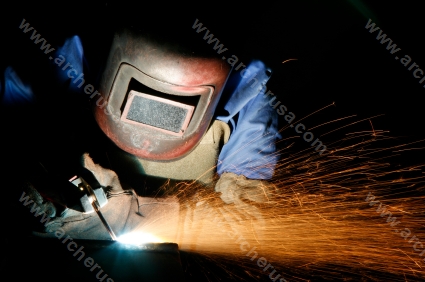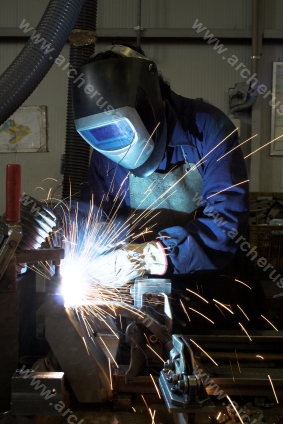|

What is welding?
Welding is a fabrication process that
joins materials, usually metals or thermoplastics,
by causing coalescence. This is often done by
melting the workpieces and adding a filler material
to form a pool of molten material (the weld puddle)
that cools to become a strong joint, with pressure
sometimes used in conjunction with heat, or by
itself, to produce the weld. This is in contrast
with soldering and brazing, which involve melting a
lower-melting-point material between the workpieces
to form a bond between them, without melting the
workpieces.
Many
different energy sources can be used for welding,
including a gas flame, an electric arc, a laser, an
electron beam, friction, and ultrasound. While often
an industrial process, welding can be done in many
different environments, including open air,
underwater and in space. Regardless of location,
however, welding remains dangerous, and precautions
must be taken to avoid burns, electric shock, eye
damage, poisonous fumes, and overexposure to
ultraviolet light.

What is Arc welding?
These processes use a welding power supply to create
and maintain an electric arc between an electrode
and the base material to melt metals at the welding
point. They can use either direct (DC) or
alternating (AC) current, and consumable or
non-consumable electrodes. The welding region is
sometimes protected by some type of inert or
semi-inert gas, known as a shielding gas, and filler
material is sometimes used as well.

What is Gas welding
The
most common gas welding process is oxyfuel welding,
also known as oxyacetylene welding. It is one of the
oldest and most versatile welding processes, but in
recent years it has become less popular in
industrial applications. It is still widely used for
welding pipes and tubes, as well as repair work. It
is also frequently well-suited, and favored, for
fabricating some types of metal-based artwork.
Oxyfuel equipment is versatile, lending itself not
only to some sorts of iron or steel welding but also
to brazing, braze-welding, metal heating (for
bending and forming), and also oxyfuel cutting.
Welding Safety
Welding, without the proper precautions, can be a
dangerous and unhealthy practice. However, with the
use of new technology and proper protection, risks
of injury and death associated with welding can be
greatly reduced. Because many common welding
procedures involve an open electric arc or flame,
the risk of burns is significant. To prevent them,
welders wear personal protective equipment in the
form of heavy leather gloves and protective long
sleeve jackets to avoid exposure to extreme heat and
flames. Additionally, the brightness of the weld
area leads to a condition called arc eye in which
ultraviolet light causes inflammation of the cornea
and can burn the retinas of the eyes. Goggles and
welding helmets with dark face plates are worn to
prevent this exposure, and in recent years, new
helmet models have been produced that feature a face
plate that self-darkens upon exposure to high
amounts of UV light. To protect bystanders,
translucent welding curtains often surround the
welding area. These curtains, made of a polyvinyl
chloride plastic film, shield nearby workers from
exposure to the UV light from the electric arc, but
should not be used to replace the filter glass used
in helmets.
Welders are also often exposed to dangerous gases
and particulate matter. Processes like flux-cored
arc welding and shielded metal arc welding produce
smoke containing particles of various types of
oxides, which in some cases can lead to medical
conditions like metal fume fever. The size of the
particles in question tends to influence the
toxicity of the fumes, with smaller particles
presenting a greater danger. Additionally, many
processes produce fumes and various gases, most
commonly carbon dioxide, ozone and heavy metals,
that can prove dangerous without proper ventilation
and training. Furthermore, because the use of
compressed gases and flames in many welding
processes poses an explosion and fire risk, some
common precautions include limiting the amount of
oxygen in the air and keeping combustible materials
away from the workplace.[41] Welding fume extractors
are often used to remove the fume from the source
and filter the fumes through a HEPA filter. |